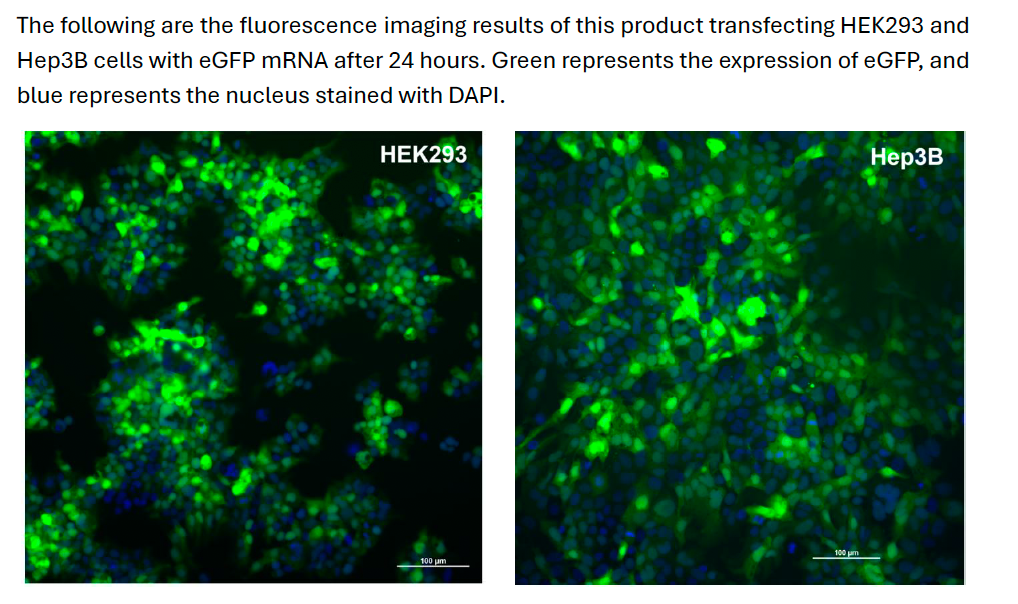Apenzy Biosciences
AccuLNP Cell Transfection Kit (For in vitro applications) NTP-0102
AccuLNP Cell Transfection Kit (For in vitro applications) NTP-0102
Couldn't load pickup availability
Product Introduction
AccuLNP is a cell transfection reagent mediated by lipid nanoparticles (LNP), used to transfect different types of nucleic acids (such as siRNA, mRNA, CRISPR mRNA/sgRNA and other small RNA biological molecules) into a variety of adherent or suspended cells. AccuLNP can efficiently combine with nucleic acid molecules to form lipid molecules + nucleic acid complexes and can effectively release nucleic acid molecules within cells to achieve their biological functions. This reagent has the characteristics of high transfection efficiency, low cytotoxicity, and easy operation. AccuLNP can be applied to the following commonly used cell lines, such as HEK293, Jurkat T cells, MCF7, Hep3B, Hela, CHO-k1, NIH/3T3, etc.
Storage condition: -20°C
Shelf life: 12 month
|
Product composition Product number |
Components |
Quantity |
|
NTP-0102-L |
Reagent L(solid) |
1 |
|
NTP-0102-E |
Reagent E(liquid) |
1 |
|
NTP-0102-A |
Reagent A(liquid) |
1 |
|
NTP-0102-ST |
Reagent ST(powder) |
1 |
The kit is good for 160 reactions in a 24-well plate.
Procedures
The following example is for transfecting firefly luciferase mRNA into HEK293 cells in a 24-well plate. The transfection reagent prepared in the example can be used for 6 wells.
Plate the cells
It is recommended to plate cells 18-24 hours before transfection. The cell seeding density is 50,000-200,000 per well. The cell density during target transfection is about 60-70%.
Prepare the lipid/RNA complex for transfection
1) Take the kit out of the freezer and thaw Reagents A and E at room temperature or in a 37°C water bath.
2) Add 200μL of Reagent E to Reagent L, use a 37°C water bath to accelerate solubilization, and the solubilization time is at least 20 minutes.
3) In a new sterile centrifuge tube (supplied by the user, such as a 1.5mL centrifuge tube), add Reagent A and 3μg of firefly luciferase mRNA to make the final volume as 22.5μL. Use a pipette to mix evenly. For other types of RNA, users can adjust the amount of RNA (such as 1, 2, 3, 4 or 5μg RNA) and test the transfection efficiency to obtain the optimal ratio of lipid to nucleic acid.
4) Add 7.5 μL of the solution prepared in step (2) to the RNA solution prepared in step (3) and use a vortex mixer to mix quickly for at least 15 seconds. The resulting total volume is 30μL.
5) Take a tube of Reagent ST, add 14 mL of sterile pure water, and mix thoroughly until dissolved.
6) Add 570 μL of the solution prepared in step (5) into the lipid /nucleic acid mixture prepared in step (4) and shake the centrifuge tube gently until mixed evenly. At this point, a total of 600μL transfection solution has been prepared.
Cell transfection
1) Before cell transfection, each well contains 400μL cell culture medium, and the cell density is within the recommended range in step 1.
2) Add the transfection solution prepared in step (6) above to each well, 100 μL per well, and gently shake the medium to disperse it evenly.
3) Continue culturing in the cell culture incubator for the required time (such as 24 hours), and then the user determines the detection method to evaluate the transfection efficiency.
Notes
- Use a 37°C water bath to accelerate the dissolution of Reagent L in Reagent E. The dissolution time is at least 20 minutes. Unused solution of Reagent L in Reagent E can be stored at -20°C. Thaw and dissolve again in a 37°C water bath for no less than 20 minutes before next use.
- During the preparation of transfection reagents, to avoid liquid loss, please use a centrifuge to collect the liquid at the bottom of the centrifuge tube after mixing the reagents in the tube.
- For different types of RNA, users can adjust the amount of RNA (such as 1, 2, 3, 4 or 5μg RNA) and test the transfection efficiency to obtain the optimal ratio of lipid to nucleic acid.
- Unused reagent ST can be stored at -20°C. Thaw and dissolve in room temperature or 37°C water bath before next use.
- Users can scale up or down the reagent use based on the procedure described in the step of "Prepare the lipid/RNA complex for transfection" to meet specific experimental dosage requirements.
Share


